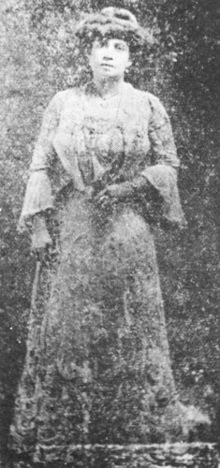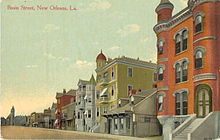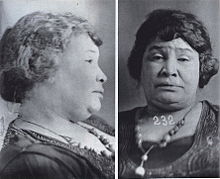- Lulu White
-
Lulu White (Lulu Hendley) was a brothel madam, procuress and entrepreneur in New Orleans, Louisiana during the Storyville period.
An eccentric figure, she was noted for her love of jewelry, her many failed business ventures, and her criminal record that extended in New Orleans as far back as 1880.
The exact dates of White's birth and death are not known. She was born on a farm near Selma, Alabama, but claimed to be an immigrant from the West Indies.[1] Publicity from about 1906 claimed that she was 31 years old (she may have actually been somewhat older). She was of mixed race, and enjoyed, for a time, an affluence rare for those of African American descent.
In 1906, she ran into financial difficulties that left her destitute[citation needed], and moved to California. She commuted back and forth between California and Louisiana several times over the course of her career and kept a high profile until the demise of Storyville.
Jazz historian Al Rose sought documentation of her death, and believed that she died at the residence of former Madam Willie Piazza in 1931.[2] However a teller at the National Bank of New Orleans reported that, in 1941, White made a withdrawal. Otherwise, no information about her post-Storyville life remains.[3]
Contents
Mahogany Hall
Until forcible closure in 1917, White ran a sumptuous brothel known as Mahogany Hall, located at 235 Basin Street.29°57′25.13″N 90°04′20.56″W / 29.9569806°N 90.0723778°W It was known as an 'Octoroon Parlor' meaning that all of the girls working there were light-skinned African Americans of mixed racial descent. The four-story house reportedly cost $40,000 to build (about $1 million in 2008 dollars). In 1929, the structure sold for $11,000.
According to publicity of the time, Mahogany Hall, housed forty women.[4] The official brochure for the house also stated that it had five parlors (one of which was a 'Mirrored Parlor') and fifteen bedrooms, each with its own adjoining bathroom. Famous Storyville photographer E. J. Bellocq's surviving photographs of the house attest to its abundance of elegant furnishings, huge chandeliers and potted ferns. The building housed several expensive oil paintings, Tiffany stained glass windows and other works of art.
Other pamphlets featured photographs and biographies of each of the 'Octoroon' girls. They also contained a supposed picture of Miss White, but it was actually another picture of Victoria Hall, one of the Octoroons.[4] Aside from Miss Hall, other known residents of Mahogany Hall included Emma Sears (The Colored Carmencita), Clara Miller, Estelle Russell, Sadie Reed and Sadie Levy.
In addition to Mahogany Hall, White operated a drinking establishment at 1200 Bienville Street. The Saloon opened in 1912 and, with the onset of Prohibition, changed to a soft drink bar. Throughout the twenties, White was brought in on charges of violating the Volstead Act. In 1929, she sold the Bienville property to New Orleans businessman Leon Heymann.
Mahogany Hall served as a House for the Unemployed in the mid-1940s but was demolished in 1949. White's Saloon building on Bienville Street was one of the handfull of Storyville buildings to survive past the 1940s, but was extensively damaged during Hurricane Betsy in 1965, losing its second story; the ground floor remains in modified condition as a 1 story building.
In popular culture
- Boston's jazz supper club Lulu White's was named in her honor.
- The film Belle of the Nineties (1934) starring Mae West is said to have been inspired by the exploits of Lulu White (the film's working title was "The Belle of New Orleans").
- In the film Pretty Baby (1978), the brothel madam played by Frances Faye wears a red wig and excessive amounts of jewelry, as Lulu White was known to do. The brothel at the center of the film also shares many characteristics with Mahogany Hall, particularly its swirling mahogany staircase.
- The song "Mahogany Hall Stomp" written by Spencer Williams and performed by Louis Armstrong[5] references White's famous establishment.
References
- ^ Rose, "Storyville, New Orleans" University of Alabama Press, pg. 40
- ^ Al Rose. Miss Lulu White de Basin Street, Nouvelle Orléans. Paris: Gaston Lachurie, 1991.
- ^ Madden, Annette; 'In Her Footsteps: 101 Remarkable Black Women from the Queen of Sheba to Queen Latifah'; Conari; pg 230
- ^ a b Rose. Storyville, New Orleans. University of Alabama Press. p. 206.
- ^ Mahogany Hall Stomp, ASCAP, ASCAP Website
External links
Categories:- American pimps and madams
- American brothel owners
- People from New Orleans, Louisiana
- 19th-century births
- 20th-century deaths
Wikimedia Foundation. 2010.



